-
Posts
22,214 -
Joined
-
Last visited
-
Days Won
67
Content Type
Profiles
Forums
Blogs
Gallery
Events
Store
Posts posted by JapanX
-
-
Often = Showa | Rare = Meiji | Very rare = Taisho
And again frequency of a meeting with that or other sign is put in a foundation of classification. Type 3 certainly dominates. This type occupies a time interval from the middle of 1920s and to the middle of 1940s. It can be found in the rare second degree on first half 20 and in a rectangular box for the third class with silver paint hieroglyphs. On the second place on frequency of occurrence there is type 1. Of course type 1 is much much scarcer than type 3. But nevertheless from time to time we run across this type. Beaten-broken, with erose top ray, threadbare gilding on a kite and sometimes simply without a pole with a kite … But you have a chance to meet him on the market. For me it is doubtless that type 1 served Russian-Japanese war.
The badge which we come across less often is type 2. For all “my time” in Japanese Faleristics (yes! with capital letters!) I met this type only couple of times. During the same time period I observed more than a dozen passes of signs type 1. If someone or something has been awarded by the third or second class of a gold kite in an interval between 1905-1920 chances of are high that this award were type 2. But here again all rests against a problem of quantity of awards during Taisho epoch. If number 3000 is valid, than it is very probable that there was only few rewardings by 3rd class. Why I do not like figure around 3000 awards? Because there is an information about 3 awards by 1st class which were made during Taisho epoch! I simply can't believe that with three 1st class rewardings we got only 2997 rewardings in all other classes. It doesn’t seem right!
I incline to think that type 1 and type 2 for some time existed in parallel and both participated in satisfaction of demand shown by Russian-Japanese war. But type 1, undoubtedly, has appeared before type 2 and took part in game since 1895. Type 2 is closer in manufacturing techniques (especially its sub-version 2.2) to type 3, rather than to type 1.
Certainly I am very disturbed by absence of type with rivets carried on corners (personally I never met this type and never saw any photos). At 4 and 5 classes such type exists, and at 3 class it is not found (at least by myself). Why? Perhaps, we should search for the answer in number of golden kites conferred in 3 class? Maybe workshop which made 4 and 5 with the carried screws simply did not receive the order on 3 class because there was no demand (or it was completely satisfied by others workshops) And maybe after all such type (with the rivets carried on corners) exists. Lies somewhere and waits for me (or for you – greedy for Kites is a terrible thing).
0 -
Here the different badge. Despite all differences in shooting it is visible that signs are identical in every detail.
 0
0 -
Type 3 Showa
The most numerous type and quite unified. A sign, which colleagues’ observe at this scan, belonged to lieutenant general Kodzhiro Uchijama. Kodzhiro Uchijama was a holder of the 2nd class. He has been awarded in the early twentieth (somewhere between 1921-1926). Exactly in this form and execution badges of the 3rd class have existed until the 1945. As I have said earlier – this type the most homogeneous among all others.
 0
0 -
Type 2.2 is extremely interesting by absolutely unusual (if not unique) execution of a beam at 12 o'clock. Beam in the top part is bent. To be exact – it is recurved. It is obvious that it is made for convenience of carrying of a sign (and not by the owner).
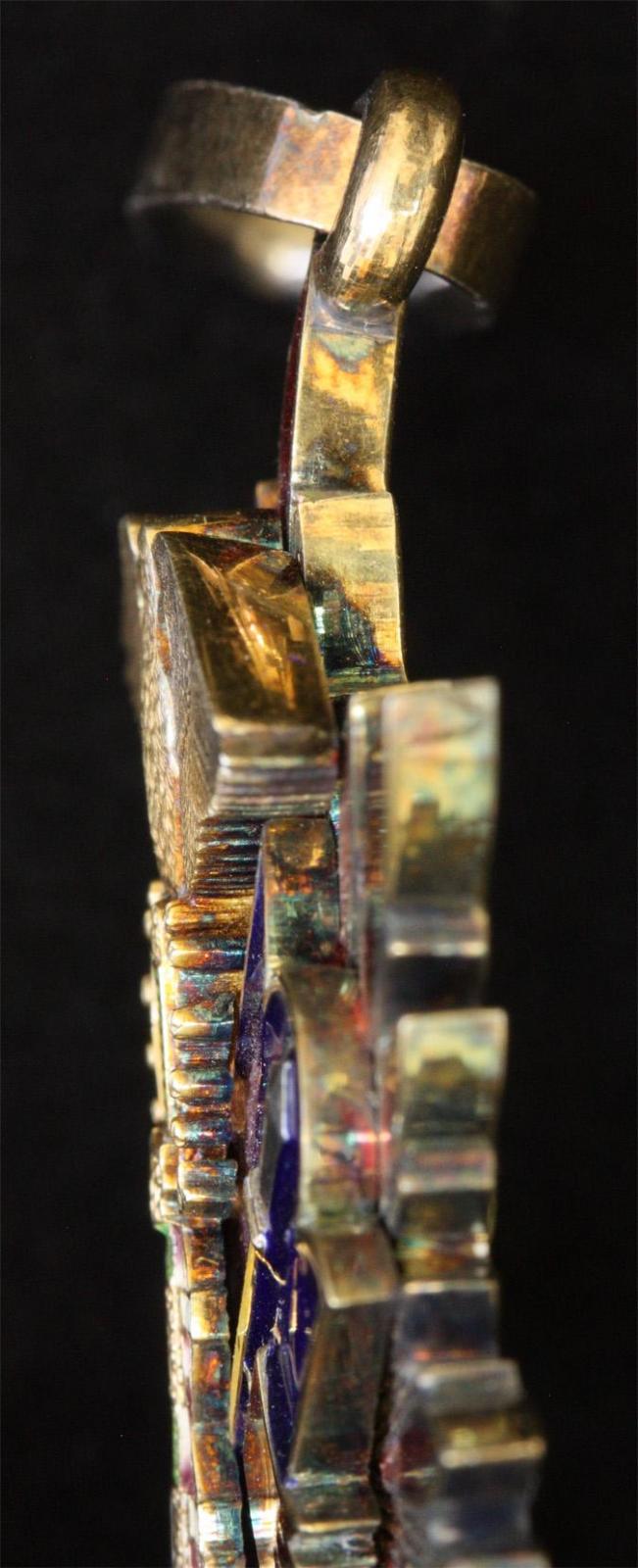 0
0 -
Type 2.2 Meiji - Taisho
Change in form of a body of a kite. Wings remain practically unchanged. Note – 2.1 and 2.2 almost twins. But as, despite their similarity, the shade of enamels on a pole differs!!! Difference not less considerable (if no more), than between type 1.1 and 1.2. The same can be said about enamel color at bottom part of a harness! And photos 2.1 and 2.2 are made on the same technique under same condition!
 0
0 -
Type 2.1 Meiji - Taisho
Substantial change in the form of a wing and body of a kite. Larger diameter of rivets. Other shades of enamel.
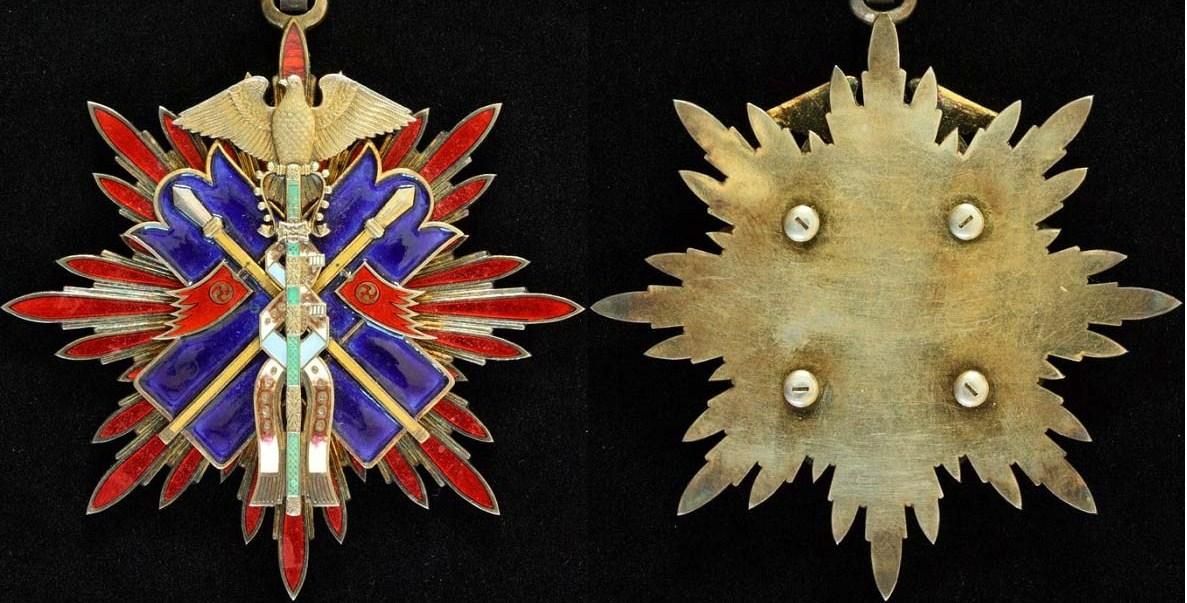 0
0 -
Type 1.2 Meiji
Excellent early sign. From the previous differs minor alteration of the form of a kites body (a neck and the bottom part) and its beak. Different execution of a pole. Other shades of enamel.
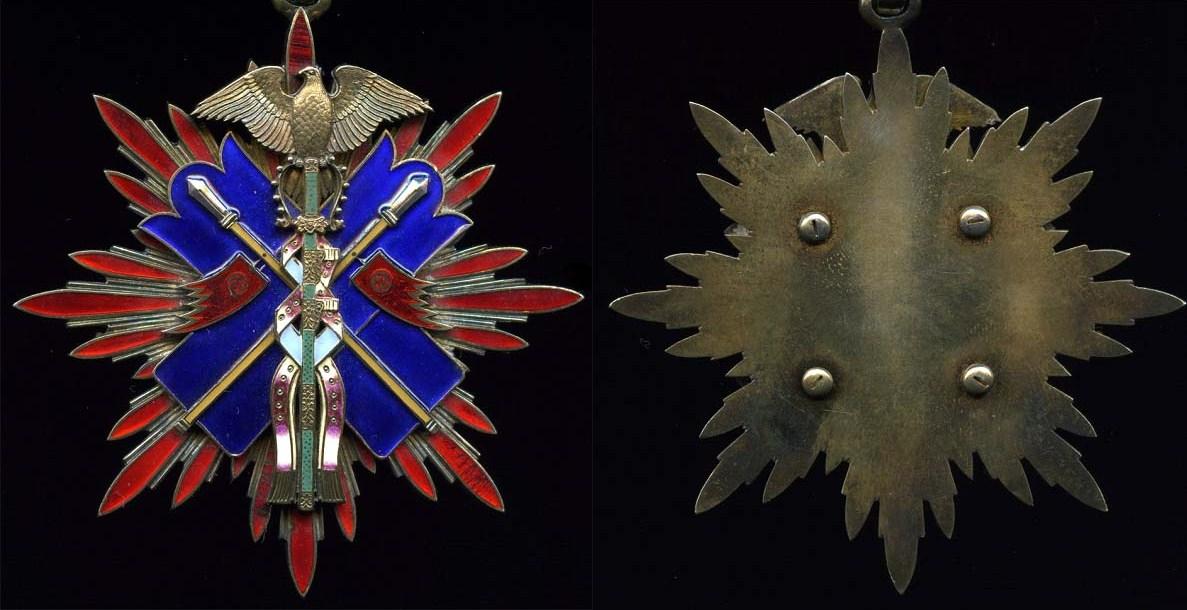 0
0 -
Type 1.1 Meiji
Excellent early sign. Classics. It is quite interesting that out of four rivets only two on the left have thin long cuts. And the cuts on right rivets have a different geometry. They are a bit shorter and wider. Especially right bottom rivet. The subsequent types have more unified screws.
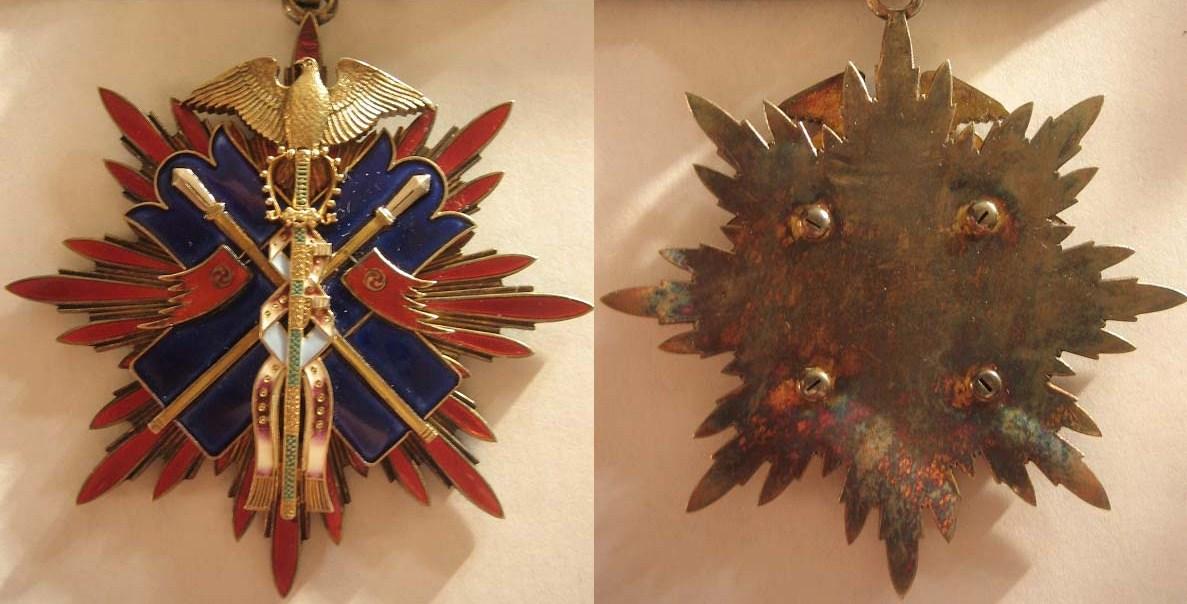 0
0 -
Now detailed (and this is not exaggeration!) photos obverses and reverses of all 5 types with my comments.
0 -
Here they are.
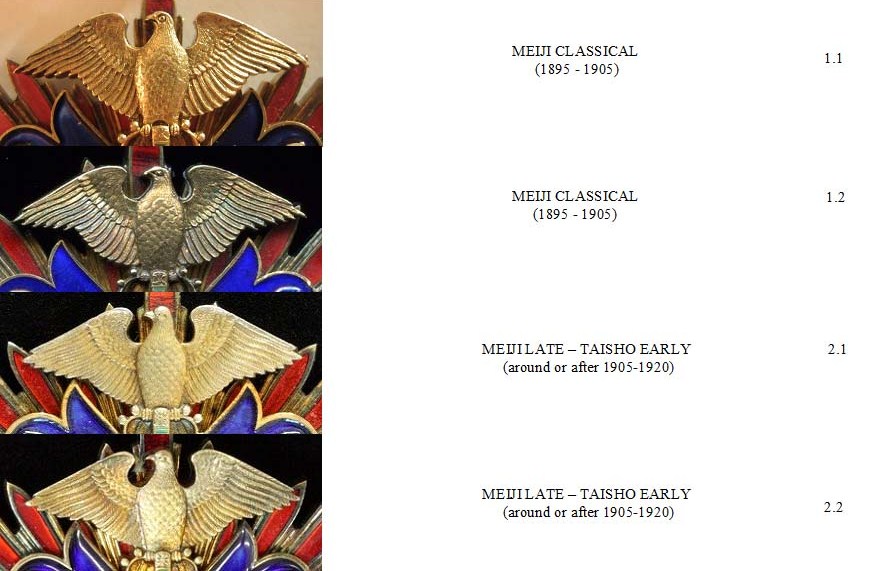 0
0 -
All three types have almost identical reverses. Position of rivets at all types almost identical.
All three types also have almost identical diameter of rivets (except for one variation of type 2).
Type 1 and type 2 each have at least two versions.
0 -
Here it comes
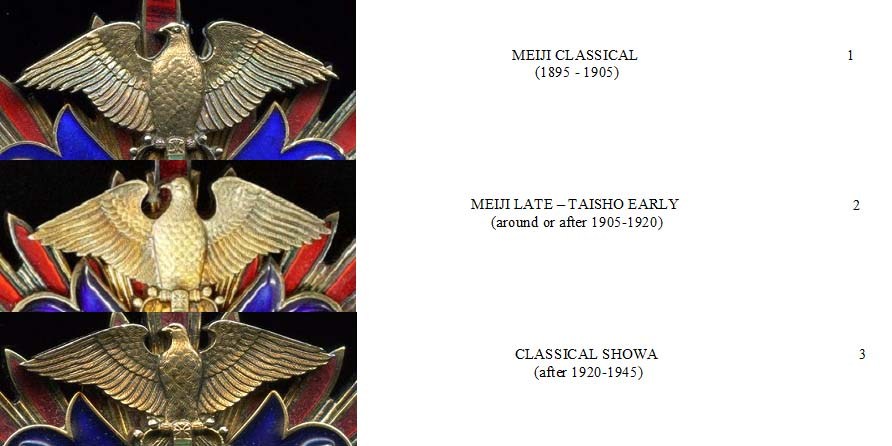 0
0 -
Here is another classification of Golden Kites. This time I suggest we discuss in every detail 3rd class of Colden Kite order. This classification (created for 3rd class) has direct reference to 2nd class. We all know that until 1942 person awarded by 2nd class received a star and a sign on the 3rd class. As well as in the previous classification (see classification for 4 and 5 classes) at this classification three columns. Left – a photo of a kite. Central – my attribution of the piece to specific time period (Meiji –Taisho–Showa). Right – number under which the given type of a kite will be mentioned in our further discussion.
0 -
An interesting examination, clearly you have put a lot of work into this. Let's all digest it and add comments once we have had a chance to absorb what you have written.
Thank you Paul for your kind response! I look forward for your comments!
I also have some ideas for classification of Kites in 6-7, 3 and 2 classes.
I`am at work right now (yes on Sunday afternoon!) and at the end of the day will try to create a new topic devoted to 3 class. I hope it will make my point more clear (as we all know 3 is a close relative of 4 and 5). I`ve got some beautiful pictures of this rare type. Hope you (and our dear colleagues) will enjoy viewing them.
Nick
0 -
Excellent dissertation!
Richard
Thanks Richard! Been reading your posts for a while (for a couple of years). Love them. Your appraisal is very important for me.
Nick
0 -
Type 4 Meiji late-Taisho early
 0
0 -
P.P.S.
Here better pictures of types 3 and 4 (they was posted in bad quality (I don`t know why)). Maybe moderator will be so kind and will replace originals with this versions (the same goes for the classification table). Sorry for that (it`s my first posts at this forum and the system is unusual for me
 )
)Type 3 Meiji late-Taisho early
 0
0 -
-
And one more comparison of two types 7.
This time two 4 classes (at the left - the beginner, and on the right old-timer).
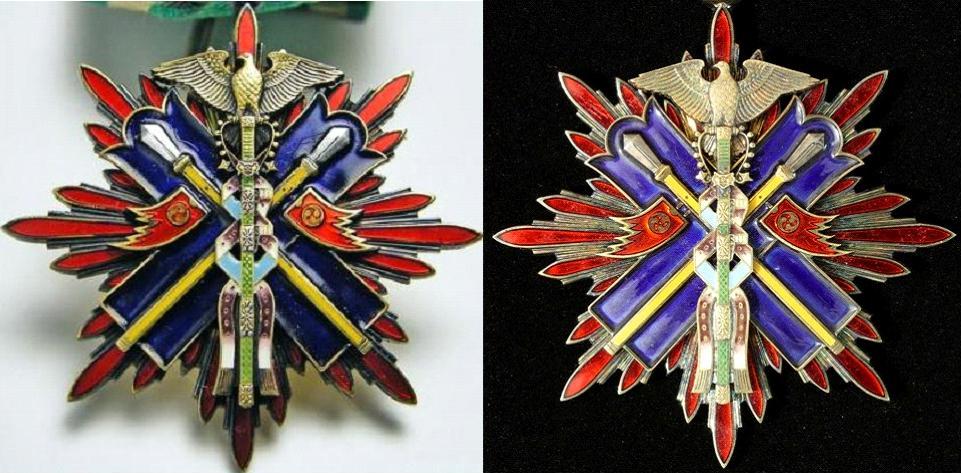 0
0 -
and here the reverses
 0
0 -
Here obverses
 0
0 -
P.S.
"I should say that from my experience this are very unstable characteristics. I mean color of the enamel"
May sound like an unsubstantiated statement.
So I have decided to provide some "documentary evidence"

Here we got two beautiful type 7 specimens (5 class on the left and 4 class on the right).
0 -
And that’s all I wanted to say (for today
 ). Will be glad to hear your comments dear colleagues.
). Will be glad to hear your comments dear colleagues.Cheers
P.S. Sorry for my rusty English
 .0
.0 -
So you don’t like rivets rule. Yep.
So what is yours rule? Here it is.
General rule of dating Golden Kites in 4th and 5th classes (sounds quite pompous
 )
)1) Check riverts! If they are centered – it may be Meiji or Showa piece, but if they carried on corners its definitely old badge most likely from Taisho.
2) Check enamel! Carrot enamel in the rays and light blue on the shields are typical for older badges and more glassy, transparent ruby-like enamel in the rays and the darkly dark blue on shields are typical for Showa badges.
3) Take a good look at the kite! Now look at the classification. Is it type 1 or is it type 7 (they are easily identifiable)? Neither? Then check out type 2,3,4,5 and 6 (for identification of the later two use riverts).
4) Check thickness of the sign! If it`s thick, than it`s old. And vice versa.
That’s mine recommendation.
0



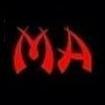

Classification of Colden Kites in 4th and 5th class (An attempt...)
in Japan
Posted · Edited by JapanX
Dear Markus,
this is definitely type 7. From the color of enamel (but it`s kinda tricky-never-know-for-sure thing!) on the pole this may be late sign (1943-1945). Especially if the reverse looks like it was not polished, but sandblasted (I am thinking about creating a new theme devoted to that issue). Of course this is only my point of view.
Anyway, nice specimen you got at Coburn Station !
All the best
Nick